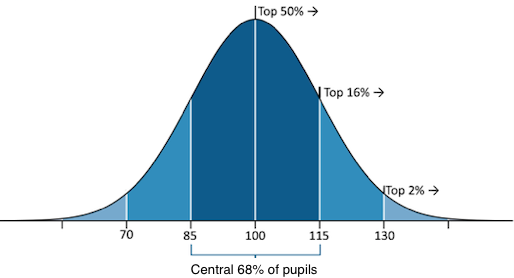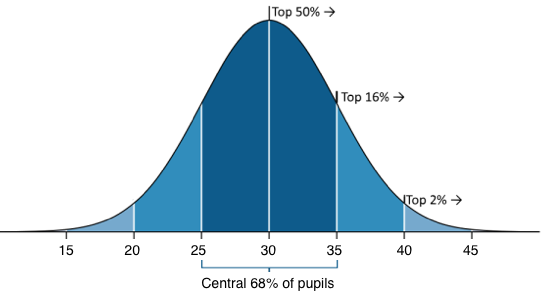Standardised Scores (SS) Explained
Question
What is the difference between “raw score”, “percentage score” and “standardised score”?
Answer
The raw score is the number of correct answers,
The percentage score is the raw score as a fraction of the total possible multiplied by 100.
The standardised score shows how the raw score compares to every other score for that test. The average standardised score is 100, standardised score can range approximately from 50 up to 150, 50% of pupils will be lower than 100 and likewise, 50% will be above 100.
This is roughly how they are split up:
2.5% are lower than 70
13.5% are between 70 and 85
14% are between 85 and 92
20% are between 92 and 100
20% are between 100 and 108
14% are between 108 and 115
13.5% are between 115 and 130
2.5% are greater than 130
Standardised scores above 130 and below 70 are rare.
The image below shows the distribution of standardised scores.

Let’s take an example.
A test has 50 questions.
The mean(average) score for the test is 30.
Let's assume 95% of pupils who sat the test scored between 20 and 40.
3 pupils; A, B and C got 20, 30 and 40 respectively in the test.
Raw Scores:
A 20
B 30
C 40
Percentage Scores:
A 40%
B 60%
C 80%
Standardised Scores:
A 70
B 100
C 130
The image below shows the distribution of raw scores.

BOFA displays the standardised score for each specific test. Each score is recalculated every night and takes into account all the new tests which have been completed during the day. Every test has a different average(mean) and different spread of the data(standard deviation), this means you can compare scores across multiple tests. Some tests may be easier than others, but generally speaking, all tests at the same level in any particular topic should in theory be similar.
How to interpret a BOFA standardised score
There are two factors to consider. The consistency of the SS over a range of BOFA tests and the value of the standardised score.
Consistency
Because these standardised scores are calculated solely on BOFA pupils who will have completed identical tests usually in the same order, we want to be looking for consistency in the standardised scores in each specific subject.
Why?
Because if a pupil gets 105 on their first test in a subject, they will receive the same amount of learning as everyone else that scored 105 on that test. So, when each child sits the next test, we would expect to see the same or similar improvement. On this next test we would also expect to see a standardised score of 105 even though they have made progress. This is the case for every child using BOFA which is why we should be looking at consistency on the standardised score rather than expecting an increase.
What does an increase in standardised score over a sequence of tests mean for a pupil?
This means that that pupil has made more progress than the majority of pupils using BOFA, or they had more assistance from a friend/parent/teacher/tutor than the average pupil. The converse is also true if a pupil's standardised scores are reducing in a subject.
Value
What does the value of a BOFA standardised score mean for a pupil?
This is much more difficult to answer because there are so many external factors to consider. A pupil that is consistently getting a high standardised score obviously has a better chance of achieving success. A pupil with a low standardised score who has done very few BOFA tests is unlikely to perform well in an examination but a pupil who has a low standardised score and has been using BOFA for a substantial period of time e.g. at least 10 months up to 3 years, has a higher the chance of achieving success because their knowledge base is increased above their peers who have not used BOFA.
If my child consistently scores 87 on a standardised score after using BOFA for 2 years, will they pass the exam?
As discussed above, yes, it is possible that they will pass the exam but there are external factors to also consider. Such as: how many of the other candidates sitting the exam have used BOFA; the distribution of ability of the pupils sitting that specific exam; and what percentage of candidates sitting that specific exam will be offered a place.
Even if we asked pupils which entrance exam for which school they were sitting we still could not accurately predict the likelihood of success.
For example, if there are 1000 pupils sitting an exam, 600 of them have used BOFA and your child has a high standardised score coming close to the top of the 600 BOFA candidates, there is no way of knowing if the 400 candidates that have not used BOFA have a greater ability. However, we do know that BOFA attracts the more able candidates which would suggest that our 600 BOFA users are generally stronger than the 400 non-BOFA users. In 2020 there were 43 Eton scholarships awarded which are possibly the pinnacle of academic achievement of pupils in that age group. 24 of the pupils awarded a scholarship used BOFA. One of these candidates had a standardised score of 92 on their first BOFA maths test.
My child scored 100% but only has a SS of 120, why is this?
This simply means that your child was not the only child to score 100% on the test. All children scoring 100% on that test will have received the same SS of 120.























